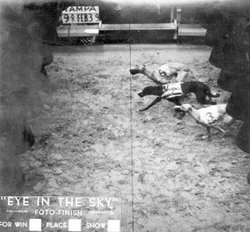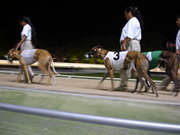Greyhound Racing
Dogs
Greyhound Racing
Greyhound | Greyhound Adoption | Rat-Baiting
 Photo finish of a greyhound race in
Tampa,
Florida,
USA on
February 9,
1939
Photo finish of a greyhound race in
Tampa,
Florida,
USA on
February 9,
1939Greyhound
racing is the
sport of racing
greyhounds.
The dogs chase a
lure (an artificial
hare or rabbit)
on a track until they arrive at the finish line. The one that arrives first is
the winner.
History
Modern greyhound racing has its origins in
coursing.
The first recorded attempt at racing greyhounds on a straight track was made
beside the
Welsh Harp reservoir,
Hendon in
1876, but this
experiment did not develop. The sport emerged in its recognizable modern form,
featuring circular or oval tracks, with the invention of the mechanical or
artificial hare 1912
by
Owen Patrick Smith. O.P. Smith had altruistic aims for the sport to stop the
killing of the jack rabbits and see "greyhound race as we see horses". The
certificates system led way to parimutuel betting, as quarry and on-course
gambling,
in the
United States during the
1920s. In
1926, armed with
the Smith patents and a hand shake, it was introduced to
Britain by an
American,
Charles Munn, in association with Major
Lyne-Dixon, a key figure in coursing, and Brigadier-General
Critchley.
The deal went sour with Smith never hearing from Munn again. Like the American,
International Greyhound Racing Association, the In.G.R.A. Munn and Critchley
launched the
Greyhound Racing Association, and held the first British meeting at
Manchester's
Belle Vue. The sport was successful in cities and town throughout the
U.K. - by the end of
1927, there were
forty tracks operating. The sport was particularly attractive to predominantly
male working-class audiences, for whom the urban locations of the tracks and the
evening times of the meetings were accessible, and to patrons and owners from
various social backgrounds. Betting has always been a key ingredient of
greyhound racing, both through on-course bookmakers and the
totalisator, first introduced in
1930. Like
horse
racing, it is popular to bet on the greyhound races as a form of
parimutuel gambling.
In common with many other sports, greyhound racing enjoyed its highest
attendances just after the
Second World War—for example, there were 34 million paying spectators in
1946. The sport
experienced a decline from the early
1960s, when the
1960
Betting and Gaming Act permitted off-course cash betting, although
sponsorship, limited television coverage, and the later abolition of on-course
betting tax have partially offset this decline.
Greyhound racing is undergoing a resurgence in popularity as more and more
people discover it as both a sport and a form of gambling.
Greyhound racing today
 Several greyhounds before a race
Several greyhounds before a race
Today greyhound racing continues in many countries around the world. The main
greyhound racing and gambling countries are:
- Australia
- Ireland
-
United Kingdom
-
United States In the United States there are greyhound tracks in the
following 15 states
- Alabama
- Arizona
- Arkansas
- Florida
- Colorado
-
Connecticut
- Iowa
- Kansas
-
Massachusetts
-
New Hampshire
- Oregon
-
Rhode Island
- Texas
-
West Virginia
- Wisconsin
- New Zealand
Smaller scale greyhound racing is ongoing in:
- Many European Countries
- Argentina
- Brazil
- China
(only in Macau)
- Mexico
- Spain
- Pakistan
- Vietnam
Treatment of racing dogs
Living Conditions
In many of the countries where there are large greyhound race tracks with
gambling, the dogs live in kennels at or near the track or by their trainers.
In the United States, the kennels are indoor crates stacked two levels high,
with the females usually kept on the upper level, and males on the lower level.
While the space allocated to each dog varies between locations, typical crate
size is 3-1/2 feet wide by 4 feet deep by 3 feet high. While living on the track
these dogs will spend most of their time in these kennels.
In several European countries (Belgium,
Denmark,
Czech Republic,
Finland,
France,
Germany,
Hungary,
Netherlands,
Sweden,
Switzerland) greyhound racing is carried out by the owners of the dogs
without financial interest. This amateur form of the sport is also found in some
countries, such as the United States, where professional racing exists. In these
countries the dogs often live as pets.
In Australia
In Australia live in kennels at night that meet stringent guidelines set by
the The Greyhound Racing Authorities in Australia, and by day many greyhounds
are put into running yards or day yards to keep them entertained and exercised.
The aim is to keep greyhounds as fit, happy, and healthy as possible.
Greyhounds are checked for parasites, mulnurishment, or any other medical
conditions by an on-course vet before being able to compete.
The Greyhound Racing Authorities in Australia heavily observe and regulate
greyhound welfare and living conditions and all racing authorities in Australia
finance Greyhound Adoption Groups, which home dozens of greyhounds a month.
Medical Care
In places that allow gambling on Greyhound racing the owners often treat the
dogs as short-term investments. This often means that the care they receive is
intended only to help them perform on the track, not for their long-term health.
Greyhound adoption groups frequently report that the dogs from the tracks
have tooth problems the cause of which is debated although it is likely related
to either a low-quality raw meat diet or damage to the gums from chewing on
metal cage bars. The groups often also find that the dogs carry
tick-borne diseases
and parasites due to the lack of proper preventative treatments. Due to the
dense living conditions in the kennels, the dogs require regular vaccination to
minimize outbreaks of diseases like kennel cough.
After the dogs are no longer able to race (generally, a greyhound's career
will end by the age of three or four), owners either keep the dog for breeding
or dispose of the dog. They will sometimes have ex-racing greyhounds euthanized
if they do not want to go through the expense of finding the dogs homes. The
ratio of dogs killed to those adopted is greatly debated. There is much debate
between the racing industry and anti-racing activists about the quality of the
dog's care making the exact details hard to determine.
Recently,
doping has also emerged as a problem in Greyhound racing. The racing
industry is actively working to prevent the spread of this practice; attempts
are made to recover urine samples from all greyhounds in a race, not just the
winners. Greyhounds from which samples can not be obtained for a certain number
of consecutive races are subject to being ruled off the track. Violators are
subject to criminal penalties and loss of their racing licenses by state gaming
commissions and a permanent ban from the National Greyhound Association. The
trainer of the greyhound is at all times the "absolute insurer" of the condition
of the animal. The trainer is responsible for any positive test regardless of
how the banned substance has entered the greyhound's system.
Several organizations, such as British Greyhounds Retired Database,
Adopt-a-Greyhound and National Greyhound Adoption Program, try to ensure that as
many of the dogs as possible are adopted. Some of these groups also advocate
better treatment of the dogs while at the track and/or the end of racing for
profit. In recent years the racing industry has made significant progress in
establishing programs for the adoption of retired racers. In addition to
actively cooperating with private adoption groups throughout the country, many
race tracks have established their own adoption programs at various tracks.
In recent years, several state governments in the
United States have passed legislation to improve the treatment of racing
dogs in their juristiction.
In venues where greyhound racing does not involve gambling, the dogs are
almost invariably pets and are, therefore, generally well treated.
See also
External links
-
http://www.agcouncil.com, The American Greyhound Council (Joint NGA &
AGTOA Welfare Organization)
-
http://www.worldgreyhoundracingfederation.com, Global Association of all
greyhound racing organizations
-
http://www.thedogs.co.uk, a British greyhound racing board
-
http://www.dog-track.co.uk UK greyhound racing information
-
http://www.igb.ie, an Irish greyhound racing board
-
http://www.cgrc-europe.com, Continental Greyhound Racing Federation
-
http://www.grl.fi/engl.htm, the Finnish Greyhound Racing Association
-
http://www.grv.org.au, Greyhound Racing in Australia Victory
-
http://www.greyhound-data.com, Comprehensive database covering greyhound
pedigrees, races, stadiums, and adoption worldwide
-
http://www.greyhounds.org Greyhound Protection League, a group critical
of the racing industry
-
http://www.globalgreyhounds.com An international forum for the greyhound
racing industry
-
http://www.rescuedgreyhounds.com An adoption website for racing
greyhounds in the United States
-
http://www.greyhounds.org/gpl/contents/media_cases2.html List of abuse
cases reported by the Greyhound protection league.
-
http://www.usadog.org/ USA Defenders of Greyhounds, a group working to
protect racing greyhounds
-
http://www.grey2kusa.org Grey 2K USA
Home | Up | List of Dog Sports | List of Protection Sports | Badger-Baiting | Bait | Dog Fighting | Sled Dog | Greyhound Racing | Canicross | Carting | Companion Dog Title | Coursing | Dachshund Racing | Disc Dog | Dog Agility | Dog Harness | Dog Racing | Dog Scootering | Dog Show | Drag Hunting | Flyball | Lure Coursing | Mushing | Musical Canine Freestyle | Pulka | Schutzhund | Sheepdog Trial | Skijoring | Tracking | Weight Pulling | Wiener Nationals
Dogs, made by MultiMedia | Free content and software
This guide is licensed under the GNU
Free Documentation License. It uses material from the Wikipedia.
|




